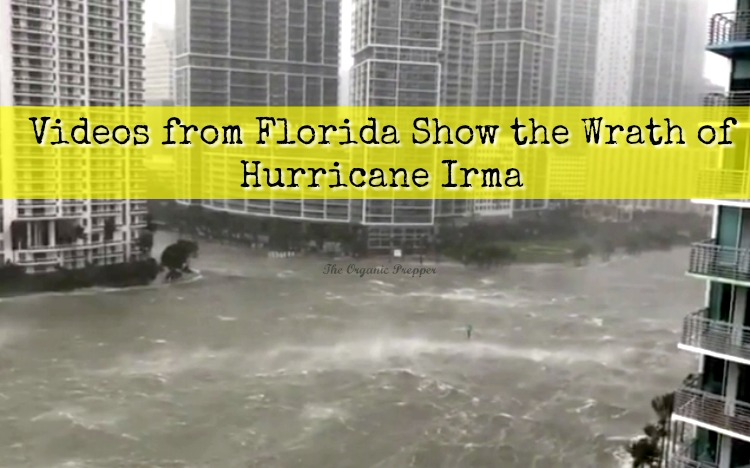If you're new here, you may want to subscribe to my RSS feed. Thanks for visiting!
By Daisy Luther
If a picture is worth a thousand words, then a video is worth a million. Below you’ll see videos from different parts of Florida that show you the true wrath of Hurricane Irma.
Irma first made landfall in the Florida Keys as a Category 4 hurricane. The second landfall occurred as a Category 3 on Marco Island.
In some positive news, Irma lost power over night and was been downgraded to a Category 1 by the time it hit Tampa and St. Petersburg.
Millions of Floridians are without power. (Last night it was estimated that 7 million people were in a blackout.) Florida Power and Light has said that the restoration will be a “slow and dangerous process that could take weeks.” (source)
Key West
The storm also pulled the water away from Key Largo.
Naples
Marco Island
(Umm…why is that guy out there with his motorcycle?)
Tampa
Irma also drained Tampa Bay.
Miami
Updates to come…
I’ll be adding more videos throughout the day.
The danger isn’t over yet, even though the Hurricane has been downgraded. A CNN meteorologist tells us what to expect:
Irma is moving up through Florida Monday morning, said CNN meteorologist Taylor Ward. The storm will weaken as it travels over land. The storm’s eye will move through southern Georgia by Monday afternoon. There is the potential for hurricane-force winds of at least 74 mph in northern Florida and southern Georgia, Ward said, and tropical-storm-force winds of least 35 mph will be felt in the Atlanta metropolitan area later.By late Monday, the storm will reach northern Alabama but the impact will be felt well in advance because of its size, Ward said. There is also the threat of tornadoes in southeast Georgia and coastal South Carolina, Ward said.
The storm is expected to move on to western Tennessee by late Tuesday, Ward said.“While the worst is over for southern Florida, the flood and wind threat will continue for portions of northern Florida, Georgia, Alabama and Southern Carolina,” he said. (source)
- Sign up for my daily newsletter for updates and preparedness information
- What To Do If You CAN’T Evacuate Before a Hurricane
- What To Do AFTER The Disaster – Free PDF
- What You Need to Know About Health Hazards After a Flood
- Replacing Documents After a Disaster
Share what you know…
Feel free to share links to videos or information about the damage. If you have been personally affected, please share your story for inclusion in an upcoming article.
For those of you suffering, please know that our hearts are with you.
















3 Responses
It already appears as if the damage in Houston was far worse. All in all I would say Florida dodged a bullet, especially regarding the enormous hype the storm generated. I live in N.Fl Tallahassee and our home did sustain minor damage as the wind drove a small branch into the roof. We woke up to a wet bathroom floor. There was near hysteria in this small capital city, and water and canned goods were gone by Friday and not restocked! The motels/hotels were all full by Friday as well. Always keep plenty of water and non-perishable foods, flashlights, matches/candles stored in your home. You will avoid the panic of the majority whom do not. I am so glad I did not have to get caught up in the panic to find water. Why do people insist on living in trailers on the coast of Florida?
This is quite astonishing. I hope that the storms quickly dissipates and more destruction will not occur.
If you live in the new path of Hurricane Irma, remember to prepare, especially for flooding. If you are at risk of being in a flood zone, then a good hint for preparing is to start filling sand bags. Then sandbag all doorways/windows to prevent water from getting in. If you look, you can find many new technologies to replace sandbagging, but sandbagging is often the cheapest.
this article caught my eye:
Tests reveal extremely toxic floodwater in Houston after Hurricane
Harveyhttp://wgntv.com/2017/09/12/tests-reveal-extremely-toxic-floodwater-in-houston-after-hurricane-harvey/
WGN-TV
September 12, 2017
HOUSTON, TX — Some of the flooding left behind by Hurricane Harvey is now making people sick. The New York Times reports it had the high water in two Houston neighborhoods tested. One site had levels of e-coli that were 135 times what is considered safe. Elevated levels of lead, arsenic and other heavy metals were also found. Some of the highest levels are being found in water inside homes. Experts say the conditions are ideal for bacteria to grow because it’s warmer inside homes and the water has been stagnate for days.
Hospital workers say more people are showing up with skin infections, which can be treated with antibiotics. Dr. Beau Briese, an emergency room physician at Houston Methodist Hospital, told the Times he has seen a doubling in the number of cases of cellulitis (reddened skin infections) since the storm. He said the infections had been successfully treated with antibiotics.
Dr. David Persse, the chief medical officer of Houston, said residents caring for children, the elderly and those with immune disorders should try to keep them out of homes until they have been cleaned.